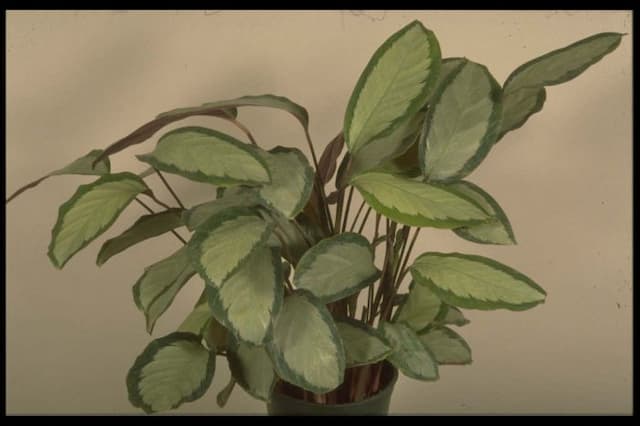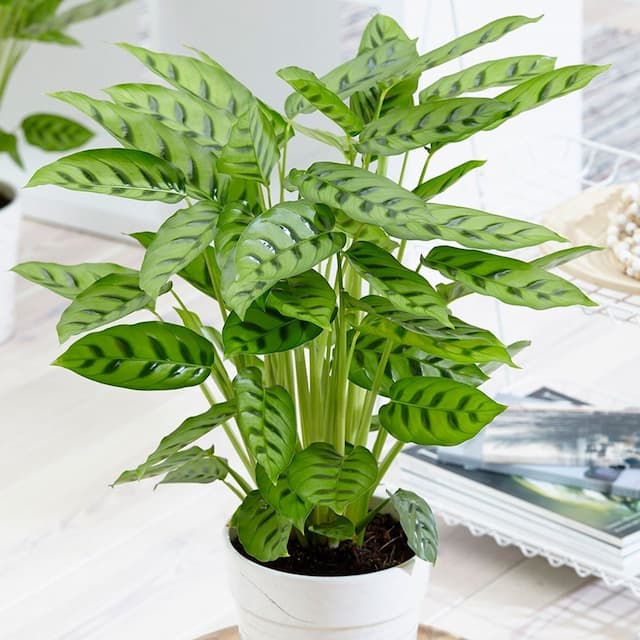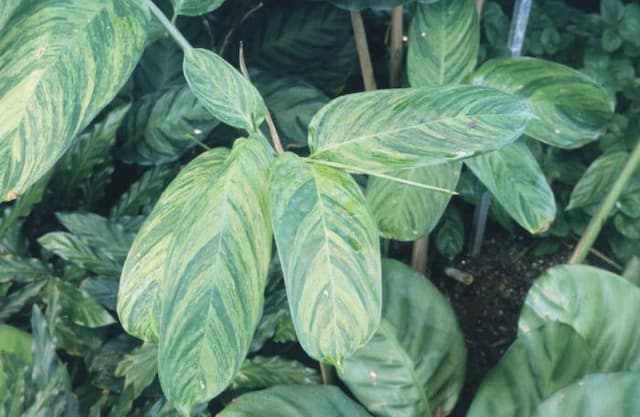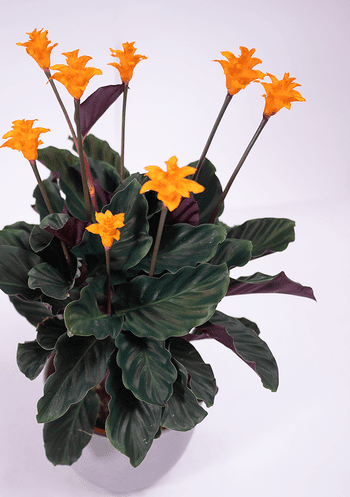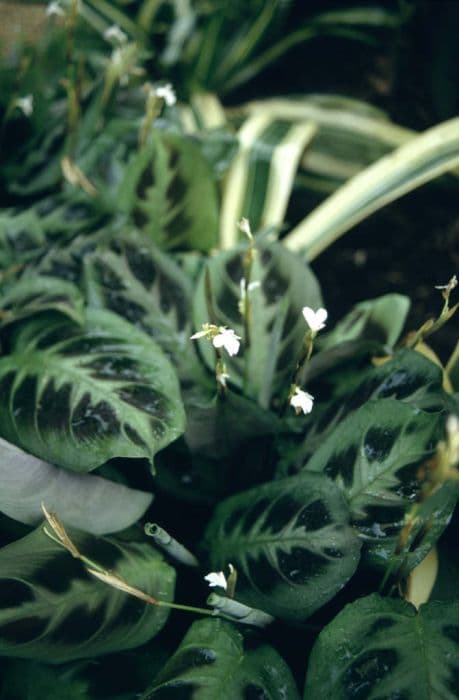Zebra plant Goeppertia zebrina

ABOUT
The plant commonly known as Zebra plant, exhibits striking foliage that serves as its primary ornamental feature. The leaves of the Zebra plant are elongated, with a glossy texture and a dark green coloration. Each leaf is adorned with distinctive stripes that run along the length of the leaves, resembling zebra stripes, which vary in shade from a lighter green to a creamy white hue. These stripes are often bold and make a sharp contrast against the darker green of the leaves, creating a visually striking pattern. The leaves emerge from a central point, arching outward gracefully in various directions, giving the plant a lush and tropical appearance. The undersides of the leaves are no less beautiful, painted in a deep purple or maroon color, which adds to the depth of its visual appeal. These colorful undersides are a surprise element that becomes more visible when the leaves are viewed from certain angles or when they naturally droop or bend. While the Zebra plant is primarily grown for its ornamental foliage, it might occasionally produce flowers. These blooms are typically not the main attraction and are small compared to the bold leaves. When they do appear, they are not as bright or conspicuous as the foliage, which always remains the star of the show. Overall, the interplay of color, pattern, and leaf structure in the Zebra plant makes it a popular choice for both indoor and outdoor plant enthusiasts, who wish to add a touch of exotic flair to their collection. Its ornate leaves catch the eye and can stand out in a diverse array of plant groupings, complementing both subtle and bold companions.
About this plant
 Names
NamesFamily
Marantaceae.
Synonyms
Zebra Plant, Zebrina, Zebrine, Purple Waffle Plant, Silver Waffle Plant, Red Flame Ivy, Red Ivy, Metallic Peperomia, Red-veined Prayer, Maranta Zebrina.
Common names
Calathea zebrina, Maranta zebrina, Phrynium zebrinum, Phyllodes zebrina.
 Characteristics
CharacteristicsLife cycle
Perennials
Foliage type
Evergreen
Color of leaves
Mixed
Height
2 feet (0.6 meters)
Spread
2 feet (0.6 meters)
Plant type
Herb
Hardiness zones
11
Native area
Central America South America
Benefits
 General Benefits
General Benefits- Aesthetic Appeal: The Zebra plant features striking foliage with deep green and silvery-white stripes, offering a visually appealing addition to home decor.
- Low Maintenance: It is relatively easy to care for when provided with the right environment, making it suitable for beginners.
- Humidity Promotion: Enhances humidity in its immediate vicinity, benefiting other humidity-loving plants when grouped together.
- Shade Tolerance: Can thrive in low-light conditions where other plants might not, perfect for spaces with limited natural light.
- Mood Booster: The lush appearance and vibrant colors can improve mood and create a more relaxing atmosphere.
 Medical Properties
Medical PropertiesThis plant is not used for medical purposes.
 Air-purifying Qualities
Air-purifying QualitiesThis plant is not specifically known for air purifying qualities.
 Other Uses
Other Uses- Goeppertia zebrina, commonly known as the Zebra Plant, can be used in terrariums due to its attractive foliage and preference for high-humidity environments.
- Its striking leaves can be incorporated into floral arrangements as an exotic and long-lasting greenery accent.
- The plant can serve as an educational tool for botany students learning about patterns and pigmentations in leaves due to its unique zebrine patterns.
- Since the Zebra Plant thrives in indirect light, it works well in office environments that may have limited natural light day.
- Zebra Plant leaves can sometimes be used in art projects, such as leaf painting or printing, due to their distinct pattern and shape.
- This plant can be used as a natural humidity indicator; its leaves may curl when the environment is too dry, signaling the need for a more humid atmosphere.
- The Zebra Plant is popular in feng shui for adding a visual softness and organic shapes to a space, which can create a more balanced and peaceful ambiance.
- The vivid patterns on its leaves can be inspirational for designers and artists looking for natural patterns to incorporate into textiles or graphic designs.
- In photography, the plant's unique appearance can be used to add an intriguing and natural element to interior shots or as a background for macro photography.
- When grown as a companion plant, the Zebra Plant can be placed alongside other shade-loving species, creating a lush, jungle-like understorey in container gardens.
Interesting Facts
 Feng Shui
Feng ShuiThe Zebra Plant is not used in Feng Shui practice.
 Zodiac Sign Compitability
Zodiac Sign CompitabilityThe Zebra Plant is not used in astrology practice.
 Plant Symbolism
Plant Symbolism- Beauty and Uniqueness: Known as the zebra plant, Goeppertia zebrina is often associated with beauty and uniqueness due to its striking striped leaves that resemble a zebra’s pattern.
- Relaxation and Stress Relief: The zebra plant is a popular houseplant that is said to bring a calming influence to the home, making it emblematic of relaxation and stress relief.
- Balance and Harmony: The contrasting yet harmonious pattern of its leaves can symbolize balance and harmony in life, where different elements come together to create a cohesive whole.
- Growth and Vitality: As a lush, green plant, the zebra plant signifies growth and vitality, representing the importance of nurturing and caring for oneself or one’s environment.
 Water
WaterFor the Zebra Plant (Goeppertia zebrina), water when the top inch of soil feels dry, typically every 1-2 weeks. During the growing season, keep the soil consistently moist but not soggy. Reduce watering in the cooler months. Each watering session should involve pouring water evenly around the plant until it begins to drain from the bottom of the pot, which usually is about 8-16 ounces for a medium-sized pot every week during active growth.
 Light
LightZebra Plant thrives best in bright, indirect sunlight. It should be placed in a spot where it's shielded from direct midday sun, which can scorch the leaves. East or west-facing windows are ideal for providing the soft morning or afternoon light that the plant prefers.
 Temperature
TemperatureZebra Plant should be kept in temperatures between 65-75°F for optimal growth. It is sensitive to cold drafts and temperatures below 60°F can be detrimental. The ideal range signifies that regular indoor temperatures are suitable for this houseplant, avoiding locations close to heaters or air conditioners that might cause sudden temperature fluctuations.
 Pruning
PruningZebra Plant benefits from pruning to encourage bushier growth and to remove any yellow or brown leaves. Prune sparingly, ideally at the beginning of the growing season (spring). Snipping just above a leaf node will promote new shoots, and this can be performed every few months or as needed to maintain the desired shape and size.
 Cleaning
CleaningAs needed
 Soil
SoilThe best soil mix for Calathea zebrina consists of a well-draining peat-based potting mix, with added perlite or pumice for aeration and improved drainage. Organic matter such as compost or bark can also be included to retain some moisture. Aim for a soil pH of 6.0 to 7.0 for optimal growth.
 Repotting
RepottingCalathea zebrina should be repotted every 1-2 years in spring or early summer. Use a slightly larger pot each time to accommodate growth. If the plant is not outgrowing its pot, refreshing the top layer of soil with new mix can be beneficial.
 Humidity & Misting
Humidity & MistingCalathea zebrina thrives in high humidity conditions, ideally between 60% and 80%. If the ambient humidity is too low, consider using a humidifier, grouping plants together, or placing the pot on a tray filled with water and pebbles to increase local humidity.
 Suitable locations
Suitable locationsIndoor
Place in moderate indirect light, maintain high humidity.
Outdoor
Grow in shade, protect from direct sun, keep moist.
Hardiness zone
11-12 USDA.
 Life cycle
Life cycleCommonly known as the Zebra plant, Goeppertia zebrina initiates its life cycle from seed, which germinates in warm and moist soil conditions within several weeks. Upon germination, the seedling emerges, developing into a juvenile plant with young leaves that start to display the characteristic zebra-striped patterns. As it grows, it matures into an adult plant with a clump of dark green, velvety leaves that are distinctly marked with lighter green or silvery stripes. Throughout its life, it forms rhizomes, which can give rise to new clonal plants, enabling the Zebra plant to spread vegetatively. Under favorable conditions, the Zebra plant may produce small, white or purple flowers, though flowering is relatively rare, especially indoors. At the end of its lifecycle, if conditions deteriorate or after several years, the plant may decline and eventually die, with seeds or rhizomes left behind to continue the species.
 Propogation
PropogationPropogation time
Spring-Summer
Propogation: The most popular method for propagating the Goeppertia zebrina, commonly known as the Wandering Jew or Zebrina, is by stem cuttings. Stem cuttings are typically taken in spring or early summer when the plant's growth is most vigorous. To propagate, select a healthy stem that is around 4 to 6 inches (approximately 10 to 15 centimeters) long and has several leaves. Cut the stem just below a node, where leaves attach; nodes are where roots are most likely to form. Remove the leaves from the lower half of the cutting to prevent decay and then place it in a container of water or directly into moist soil. If using water, ensure that the bottom nodes are submerged, and change the water every few days to keep it fresh. Roots will usually develop within a few weeks, after which the new plant can be transplanted into a pot with regular potting soil.




